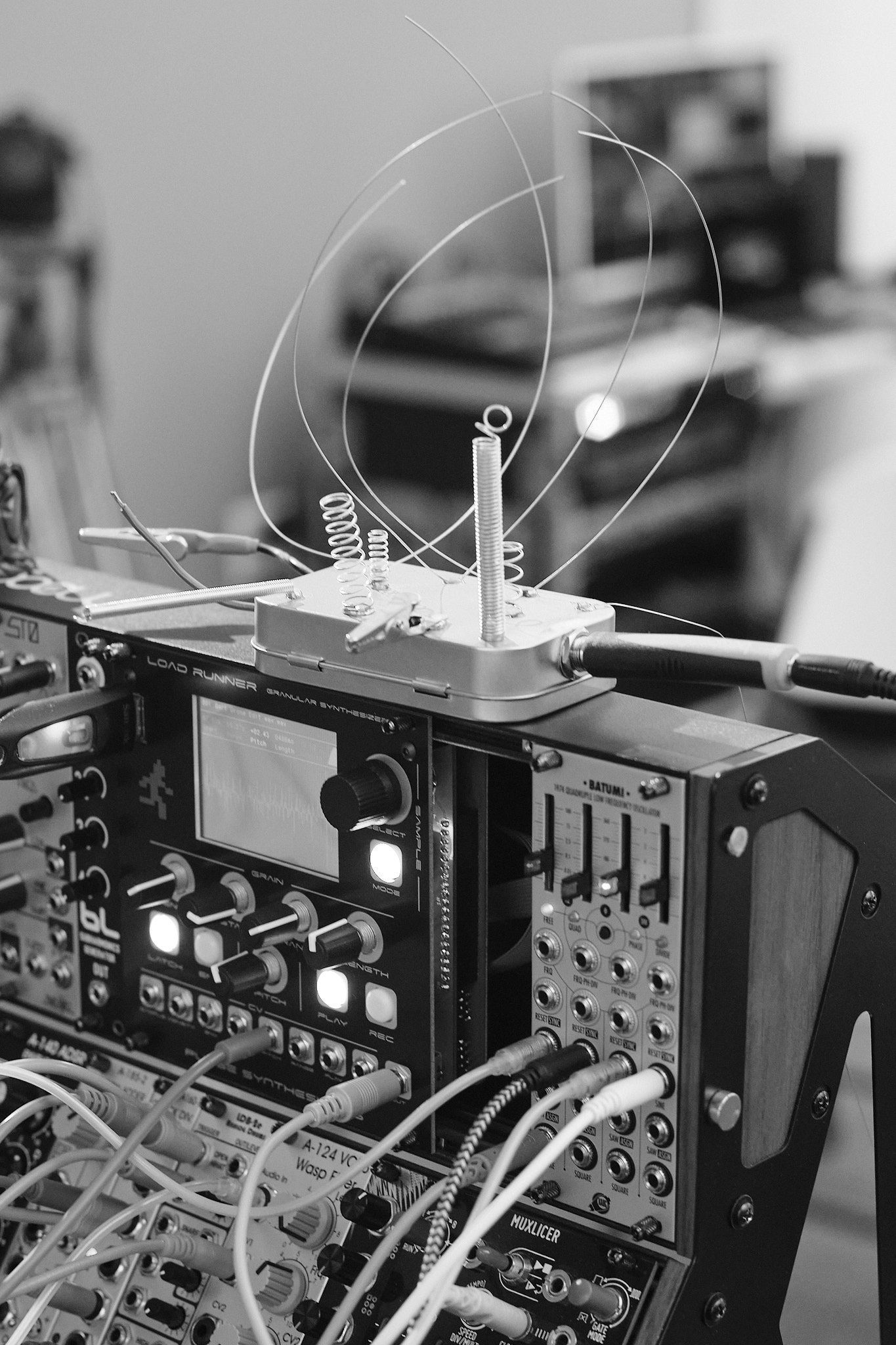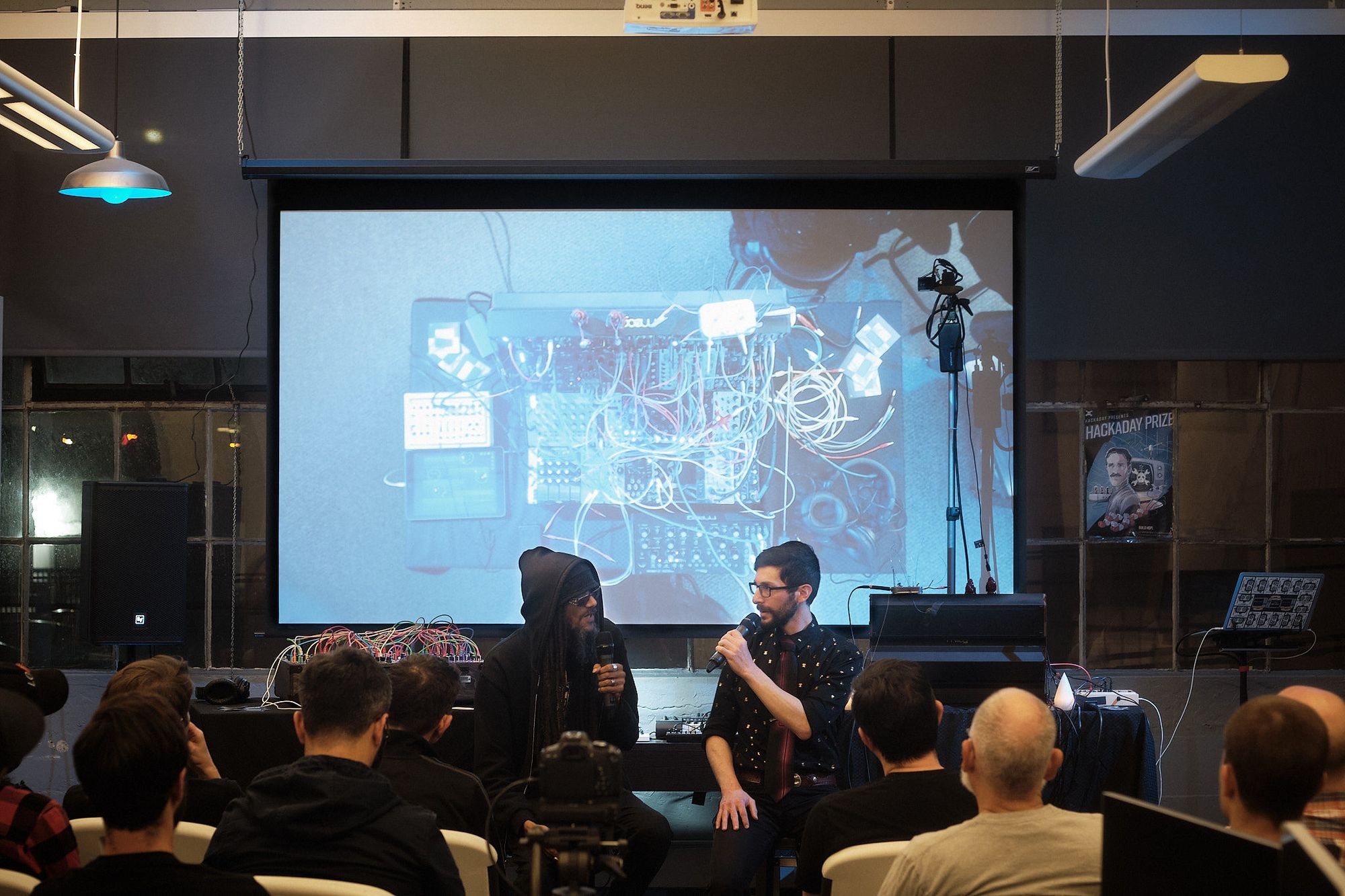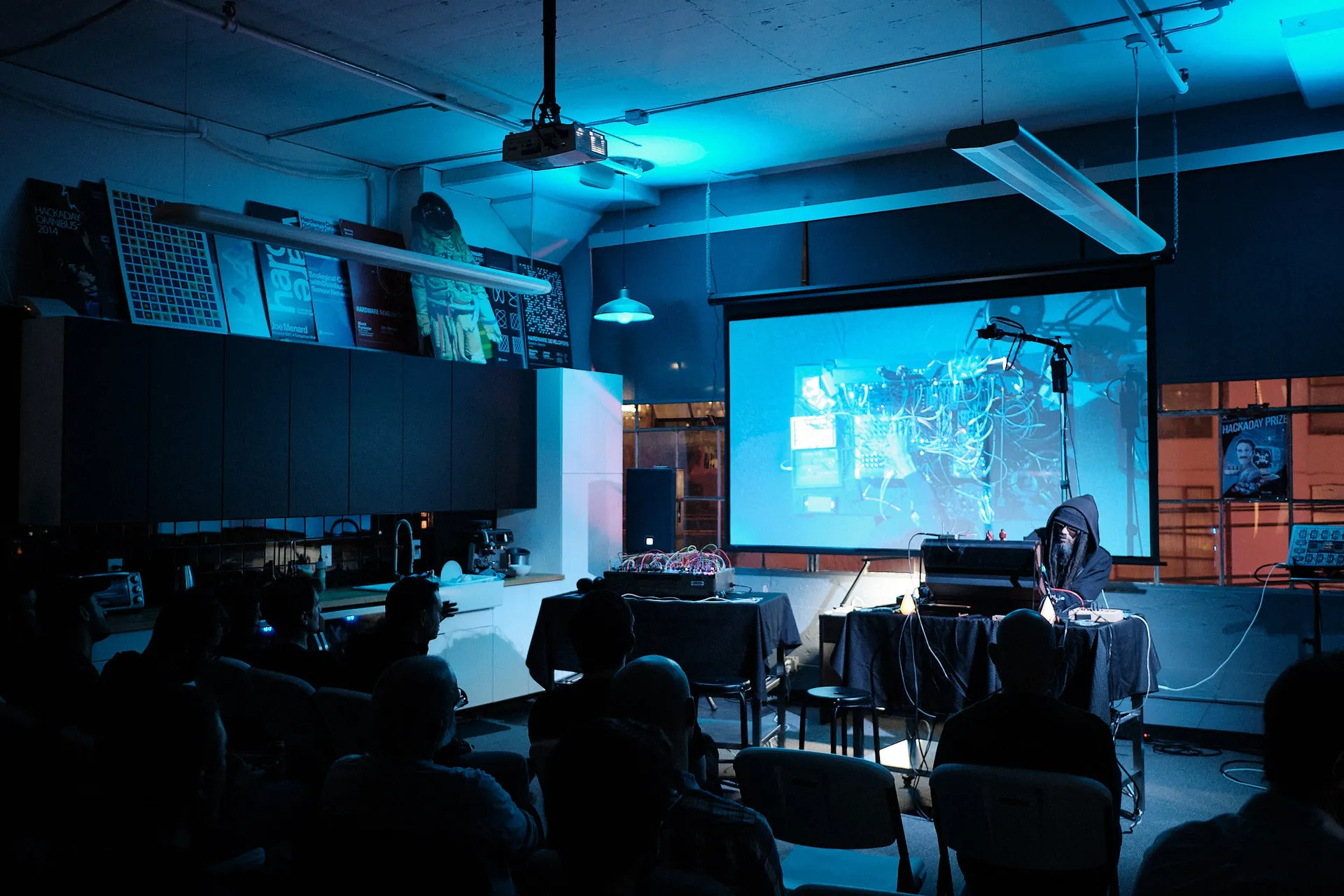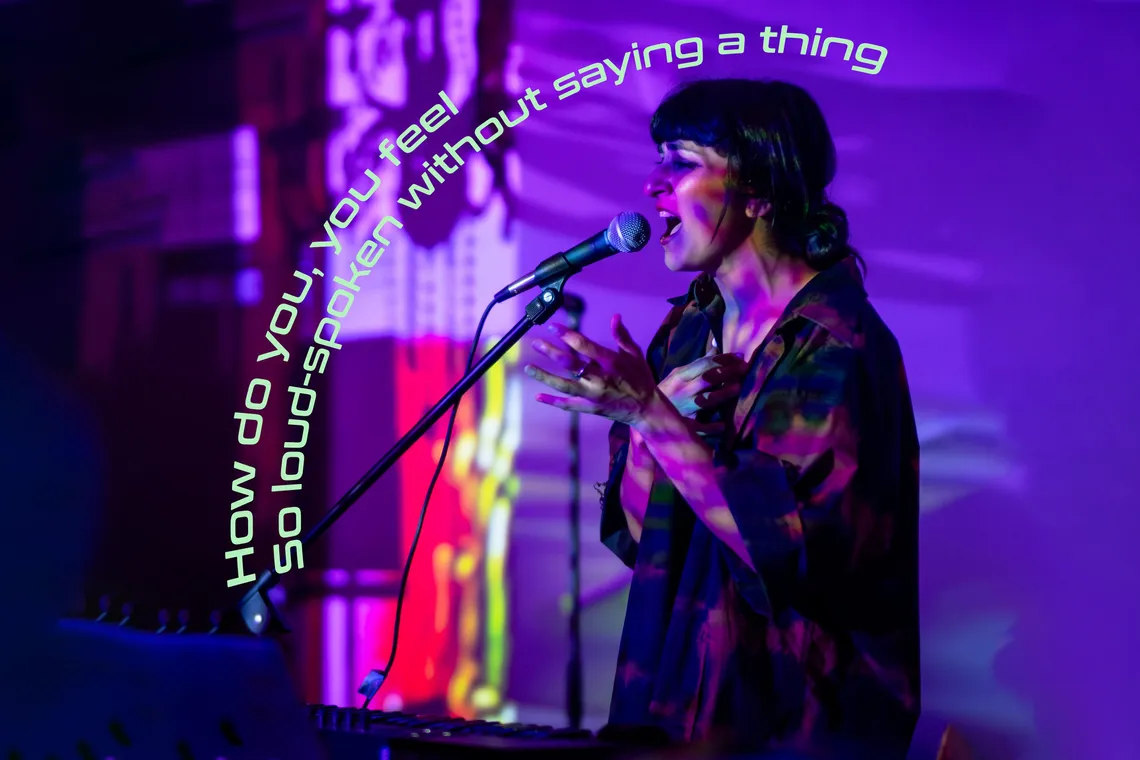Alphastare's live set creative process
In this interview from February 2020, experimental musician Alphastare, also known as Jeff, discusses his live set and creative process. He shares insights on the musical tension between chaos and control in his work, his preference for showing up cold to performances, and his use of various modules and equipment. Alphastare also touches on his incorporation of field recordings, such as capturing sounds from San Francisco's Tenderloin neighborhood, to add depth and atmosphere to his music. Throughout the conversation, he provides an intriguing look into the world of experimental electronic music and modular synthesis.
An interview with Alphastare
Korey jumps right into questions about the modules Alphastare was using that night.






The setup
Tell us a little bit about the modules you're using over here tonight. I'm also very curious about that wonderful piece you have up there.
The piece sitting on top is the Crank Sturgeon. He's a kind of a craftsman. He makes a bunch of weird electronic just devices. That's an Altoids box with a bunch of guitar strings that are hacked up and welded to it with a pickup inside of it, as well as a pickup that's attached to it. This external pickup, I wasn't actually using it tonight, but yeah.
So, I just had that running through for some textural stuff. But he also makes a whole bunch of pickup-based devices that are just kind of crazy. He does stuff that where you could submerge microphones, you could submerge in liquid, or swallow if you wanted to or whatever, you know. He's very experimental.

Borderlands iPad app
What was the app you're using?
The Borderlands app, which I've been using for a few years kind of on and off. But he just updated it recently and I haven't even taken advantage of the updates yet, but you should check out Borderlands. It's a granular sampler. You can basically feed any kind of file into it. I don't know what the video captured, but the files you can kind of move them around and you can just set up all these grains and stuff and slide the files through them. And it's the updates are cool. You can automate stuff where you can record a bunch of motions slide your files through the grains and get a whole bunch of crazy stuff and have that recorded and looping and that sort of thing. I haven't even explored any of that stuff yet. It's a super deep deep app which is good because you know it sucks when you pay a bunch of money for something and get bored of it after you know two or three tries.

Preparation
Tell me about your whole setup in general, how you got prepared for tonight.
I kind of didn't, you know? The other night when we ran into each other at Frank's awesome event, FM+1 mystery event at the Armory Club that Frank Martin puts together. Shout out to Frank Martin! Well, you brought up, "So you're ready for Wednesday?" and I said, "What?" Because I thought it was next week. I thought it was the last Wednesday of the month, you know? So I was like, "Yeah, it's a good thing we saw each other."
Preparation was basically just whatever I kind of had already patched up. I was just kind of in the middle of messing around with some stuff and exploring some things. And I just got that one module that you were asking about, I think, which is the Load Runner sampler, which has also a granular sampler that you can put files into. I was playing some of that with the Make Noise pressure points. I was able to put that—it's got a volt per octave input, you know, so you can actually play it, I was playing BART essentially. I had a drone that I recorded just going through the tunnel on BART on my phone, and I had that just sitting in there with a tiny section of that selected, you know, just looping, but with a volt per octave on it so you can kind of punch notes in and use it as a tonal device as well.
Peter Blasser modules
Do you have to order those specifically from him?
That was kind of what I was messing with there, and then the crazy noise stuff, the glitchy sounds, all that stuff, was the two modules by Peter Blasser who does this Ciat-Lonbarde stuff. If you guys are familiar with Peter Blasser, some of you probably are. He has this line of actual Eurorack modules called the Ieaskul F. Mobentheyi line, which is something, sounds like some made-up word or something. He's probably got some, it's probably different words mixed up into, you know, the letters are mixed up or something. But anyway, that was the touch capacitance thing that I was messing around with, was that one green module, and then the one next to it is one of his other ones from that series that is more of a kind of an oscillator based on bounds and bounce, the concepts of bounds and bounce, which you can look up that stuff if you're curious. It's pretty interesting to read about his.
His descriptions are really just kind of like, "What?" You know, he's just an interesting person, and the modules just sound amazing. I love his work; they're just kind of weird and you don't really know what's going on.
One I got when I was on the east coast actually stopped into Control, so that's where I got the touch capacitance one, that's called the Grassi module. And then I actually got the other one, I think I found it on Reverb, the Denum, and that's the second module that's next to that one. But he's got four or five other ones, and they all kind of come in a set. So when you order them from him, you can really only get the set or a couple of them, there's a couple of the ones you can buy loose, but they're pretty, they're kind of hard to come by in a way. But I guess if you write to him or just, you know, order from his site, otherwise used, you know, I try to find used. I got lucky and just like that one popped up and it was a pretty good deal.

Moog Mother-32
And what were you doing with the Mother-32 up there?
The Mother-32 was more or less a little bit of the classic Moog sounds that you were hearing. I was sweeping the filter on that and just kind of running that through as a pseudo lead instrument because it's got those little buttons on it, you know, I don't really have a keyboard and I don't really mess around with the controllers like Archery or any of those. There's a lot of really cool controllers out there that I've been eyeballing, but I haven't really gone down that route. I kind of just like the weird controllers and stuff. So, that's the only thing I've got that has a traditional scaled keyboard, basically, but it's just those little buttons, so you can't really do too much with it.
Capactivie controllers
I'm very much a touch plate sort of style myself. I appreciate what you have all set up there.
Nice! Yeah, I like the touch plate angle. I think I'd probably go more down that line. I think, you know, touch plate like the Microfreak or whatever that one is. Yeah, that sounds cool.
It'd be great to get your fingers on that.
I should get one of those, maybe I'll do that.

Questions from the audience
Do we have any questions from the audience tonight?
Audience: So, when I was listening to the set, I got this real sense of musical tension between what felt like railing chaos just very carefully clamped under control. And I'm wondering if you can talk a little bit about how you envision when you work a piece like this, the forcing between those two things because those seem very evident in your music, at least to me. I don't know, maybe I'm totally off base, but...
No, that's pretty perceptive. I kind of just go into a blank state, you know, and when I start to do any kind of set, I've been doing experimental music on and off since the '90s, and it's usually just something that I just show up cold, usually.
You know, which is kind of hard and dicey to do with this kind of setup, but like I said, I already kind of had this patched up for a little bit, so it was already kind of... I was playing with different sections of the modular, just kind of going through different bits where I could go, "Okay, how can I turn maybe just ride something into something else?" I wanted to just kind of pull a little bit of melody in. That's when I just pulled the Mother 32 in just to kind of get just a little bit, because I do like a little bit of melody in my music, but not totally forced, you know, and also orchestrated or... I'm not particularly a composer, so I don't really write pieces for this kind of thing, you know.
So, I think that is a part of it, but and then yeah, having that and then trying to incorporate that with just total chaos, like that one module I was just describing is just basically you put your finger on it and you don't know what the hell is going to come out of it, you know. Then you flip the little switch in the middle and these super high piercing frequencies come out that could probably hurt you, you know. So, I do like that element of danger and kind of chaos and I don't know what's gonna happen, you know. I tuned everything beforehand, at least. I started with, at least everything kind of, A432.
Audience: So, at the end of the set, and I think also at the beginning, there was this softer volume but industrial-sounding kind of drone. It almost sounded like to me it was kind of the base of the soup of the aesthetic that you had going on, that kind of crackling.
Yeah, that was the sampler I was telling you about with the BART, I guess, sample.
Audience: But my question is, when you started this patch, was that part of the beginning of the patch or did that come later? I was just thinking that how you faded that last drone, where, as far as your creative process goes, where did that drone fit into the patch and did it come at the start or was it something you added later and where do you... how do you set your patches up creatively?
That's always different, but essentially, as I was saying, I had this patched up for a minute, so I had been kind of messing around with some other things, with those kind of crazy chaos modules and stuff. But I did want to have a base for all of that to sit on top of, and that was the Pulse Synthesizers Load Runner. It's a granular synthesizer, a granular module that you could just load files into. That's what I was pointing out to you earlier. It's got just a recording from BART, you know, just a drone cycling, and I was able to kind of pitch that, you know. So, just taking that, throw something the volt per octave, and have that as one of the... I basically had three different oscillators controlled by the pressure points. So, I had the Throbbing Gristle module, the TG2 modulator, the Fusion VCO, the Erica Synths Fusion VCO, and the Pulse Synthesizers Load Runner with that sample in it, all under control from the pressure points with a different note tuned, you know, to each one. So, as close as I could, as possible to trying to kind of keep it, you know, all in tune, but... Yeah, I basically just tuned all that stuff to, I think, D. I think I'm just in D. But that was very much a basis of the patch for sure.
Audience: I was going to ask about the spoken vocal sample that was maybe about a quarter of the way in.
That was the Tenderloin.
Audience: Can you talk about that a little bit?
I just like to record stuff when I'm walking around, and then when I'm in interesting neighborhoods, I like to just kind of have something at the ready, you know. And I was just walking down, I don't even know what street, Sixth Street or something, haven't been to the Tenderloin in a while. That's probably from a year ago. So, I was just, yeah, capturing that moment.

I also noticed that you had Div Kid's Mutes in there. Was that used in your set tonight?
I did use it when those drums kicked in. I think you heard those, kind of hi-hats and stuff coming in. I had a kick going too, but I think it might have got lost in that second output module that kind of comes unconnected every once in a while. But basically, that was the one main thing I used it for, just to kind of kick those hats and stuff in. Yeah, I've only got two things going through that. Once I want to load that thing up with some more stuff and do more switching.
Alright, well Jeff, thank you again so much for coming out and playing tonight, man. It was a real pleasure to have you.
Right on, man. This guy's doing a lot of really cool stuff for the synth community and the electronic music community, and he's one of the better dressed people doing it, so take note.
Thanks, Jeff. Where can we find more of your music?
If you Google Alphastare, just all this stuff comes up. I've got just YouTube and Bandcamp and that sort of thing. Yeah, not too much of anything high professional, you know, just clips and snippets and stuff and works.
Watch the performance and interview
Watch the complete interview and listen to Alphastare's live set at the Piqued 11 meet up.
Links:
https://www.youtube.com/alphastare
https://www.instagram.com/alphastare
https://www.ciat-lonbarde.net/ifm/index.html





